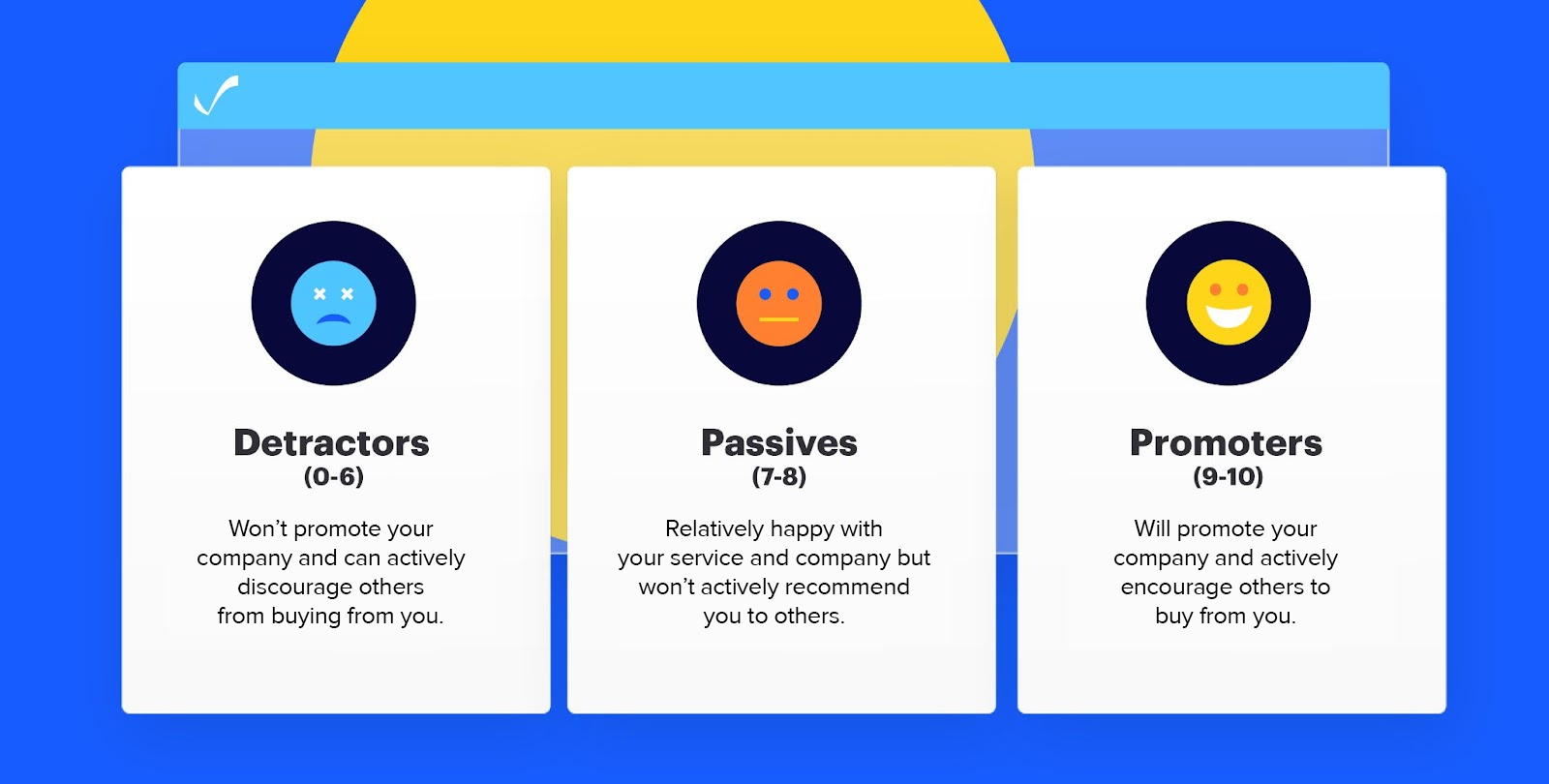These days, customer experience is king.
That’s why more than two thirds of companies say they mostly compete on improving experiences, instead of constantly engaging in price wars or upstaging each other with new product features.
The average person may think that there’s no reliable way to accurately quantify customer experience (CX) – but there is one gold standard measure. And that’s NPS.
What is Net Promoter Score (NPS®)?
NPS, short for net promoter score, is a metric that companies use to measure customer experience and satisfaction. The main benefit is that it shows how well you’re performing in the eyes of your customers. What’s more, it allows you to benchmark yourself against your competitors and monitor how effective your customer-facing decisions are.
How does it work?
NPS is represented as a numerical score, which can range anywhere from -100 to +100. When customers are given a quick survey to fill in, they can rate (on a scale of 0 to 10) how likely they are to recommend a product, brand, or service to a friend or colleague.
Respondents whose responses average from 0 to 6 are considered to be ‘detractors’, who won’t promote your company and may even talk about you negatively to their peers. But if they score an average of 9 to 10, then they’re ‘promoters’ who are likely to be fantastic advocates for your brand.

To calculate your overall NPS, simply subtract the percentage of detractors from the percentage of promoters. Alternatively, you can use our calculator here.
12 ways to improve your net promoter score (NPS)
1. Send NPS surveys at the right moment in the customer journey
If your company sells products, you should wait to send the surveys until after some time has passed since a customer’s latest purchase or consumption experience. If you offer services, keep in mind that a customer’s satisfaction levels will not stay the same throughout their service encounter. If you run a hotel, you will get different results if you ask a customer to rate their experience after they’ve just checked into a hotel room and again when they’re paying the hotel bill at the counter.
2. Personalize your email survey invites
Nothing is less appealing than a generic cold email asking customers to fill out a survey. To improve your response rates, make sure you address them by name in the main body of your emails and include compelling copy.
3. Go beyond the standard question (but don’t ask too much)
Asking the question, ‘Would you recommend us to a friend or colleague?’ is essential. But it’s equally important that you give your customers an opportunity to freely express why they’ve given a certain rating.
You can ask questions relating to the more granular aspects of your business if you deem it relevant. Just try not to ask too many questions – or your response rate will drop.
4. Make your surveys as user-friendly as possible
Long loading times, faulty buttons and confusing scale formats – these are all things that can annoy even your most passionate promoters. Well-designed surveys prevent your NPS from becoming skewed and inaccurate.
5. Engage with your detractors
It’s tempting to focus only on positive feedback, but never ignore your detractors. Take proactive steps to uncover the root cause of their complaints. According to a study from Harvard Business School, a 5% increase in customer retention can increase your profitability by up to 75%.
6. Follow up quickly
Once you decide to get in touch with a detractor, contact them quickly. According to Harvard Business Review, the average customer expects companies to help them within 24 hours via email. If your company surpasses their expectations, you increase the likelihood that they’ll become promoters in the future.
7. Don’t forget your promoters, either
As previously mentioned, companies should focus on the detractors. But at the same time, you should nurture your promoters and reward their loyalty through discounts or limited edition products. This will incentivize them to share even more about your brand.
8. Use data from your promoters to convert your passives
Passives are not usually a priority when it comes to improving your NPS, but there is a way to convert them into promoters. In short, passives need to be impressed. To find out what aspects about your product or service might impress them, identify key themes in promoters’ responses and incorporate them into your marketing communications strategy.
9. Make sure that every department knows their value
Only customer-oriented organizations find long-term success with their NPS. For this to happen, your organizational culture is key. Every employee is involved in the value delivery process (no matter how senior), so it’s essential that everyone recognizes the fact that they have an important role to play.
10. Share regular insights across your organization
Because improving NPS is a team effort, every department of your company should stay informed about the score as well as the steps they each need to take to improve customer satisfaction.
11. Empower your customer service team
Research suggests that frontline services employees who are given some autonomy are associated with higher levels of customer satisfaction. Instead of telling them to stick to a strict set of rules, train them to adopt a mindset of change. Allow them to customize their service delivery and find their own solutions to service problems.
12. Continually track your NPS
Your net promoter scores are only valuable when you track their development over time. Continue to monitor results, and it will help you analyze your business health.
CheckMarket can help with all of this – and more
Implementing all the tips above can be a challenge, but it doesn’t have to be.
CheckMarket provides a reliable and effective tool for creating NPS surveys with just a few clicks. With real-time calculations and automated follow-ups, you can easily follow your score and win back at-risk customers.
Key takeaways
- NPS, also known as net promoter score, is the ultimate metric for customer experience and satisfaction.
- It helps you discover what customers really think of your brand, and lets you benchmark yourself against your competitors.
- To calculate NPS, subtract the percentage of detractors from the percentage of promoters.
- Improving your NPS score involves many aspects. The way surveys are designed and distributed play an important role, but so does the way you and your organization engage with the data.
Interested in learning more? Download our free ultimate guide to NPS.
NPS, Net Promoter and Net Promoter Score are registered trademarks of Satmetrix Systems, Inc., Bain & Company and Fred Reichheld.


Laisser un commentaire